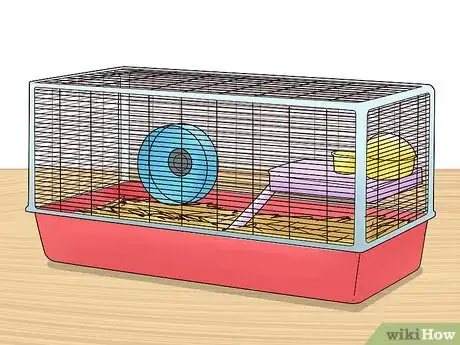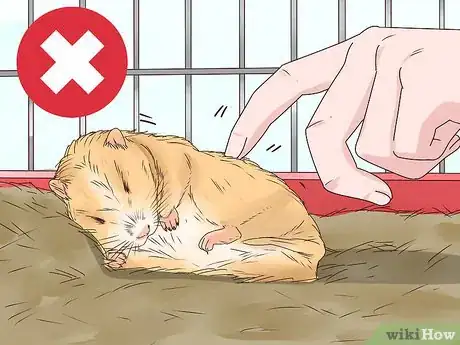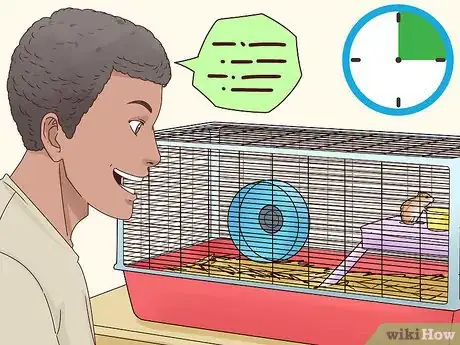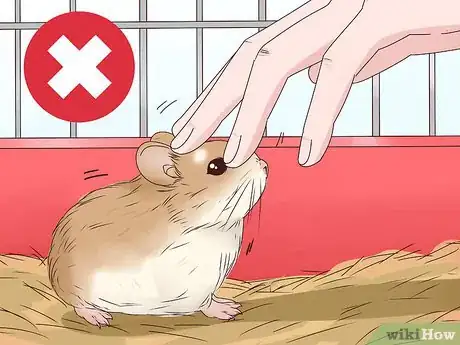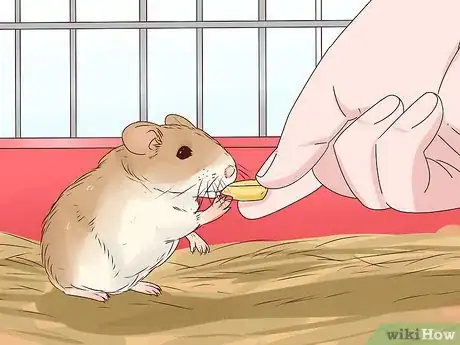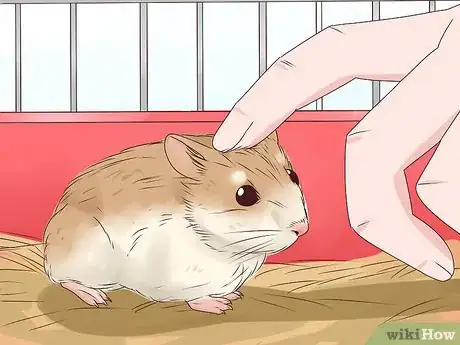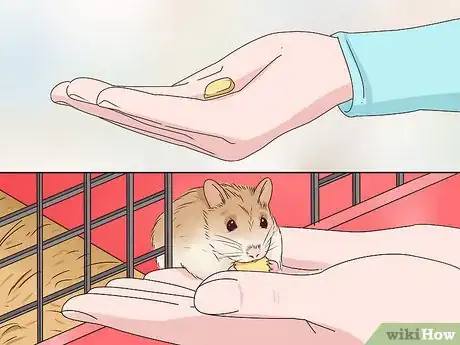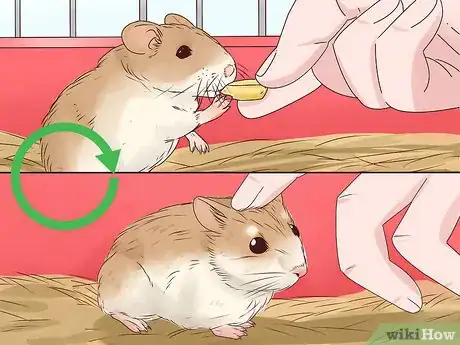This article was co-authored by Pippa Elliott, MRCVS. Dr. Elliott, BVMS, MRCVS is a veterinarian with over 30 years of experience in veterinary surgery and companion animal practice. She graduated from the University of Glasgow in 1987 with a degree in veterinary medicine and surgery. She has worked at the same animal clinic in her hometown for over 20 years.
wikiHow marks an article as reader-approved once it receives enough positive feedback. This article received 12 testimonials and 89% of readers who voted found it helpful, earning it our reader-approved status.
This article has been viewed 117,824 times.
Roborovski hamsters, often referred to as “Robo hamsters,” are the smallest and most skittish species of hamster around. If you’ve just adopted a Robo, you shouldn’t be surprised if it runs and hides from you at first. However, with time and patience, you can eventually get your hamster used to you. To tame your Robo, create a peaceful environment for it, acclimate it to your presence, and eventually feed it straight from your hand.
Steps
Creating a Peaceful and Stable Environment for Your Hamster
-
1Get a cage that’s at least 24 in (61 cm) long and 12 in (30 cm) wide. This is an adequate size cage for 1 Robo hamster. If you want to have more than 1, increase the size of the cage by 0.5x for each additional hamster you house in it.[1]
- For example, if you want to keep 2 hamsters, your cage should be 36 inches (91 cm) long and 18 inches (46 cm) wide. Robo hamsters are equally fine living alone or in pairs, so don’t feel like you have to keep 2 if you only want 1.
- If you decide to keep 2 Robo hamsters, make sure they are the same sex, unless you want them to create several more hamsters that you have to take care of!
-
2Put a food bowl, water bottle, and recreational material in the cage. Recreational material should be things that the hamster can play on or in, such as an exercise wheel and tunnels, as well as a place to sleep. The sleeping spot should be an enclosed area, such as a sleeping hut, where the hamster can feel safe as it sleeps.[2]
- Sleeping huts for hamsters are available to be bought at any pet store that sells hamster materials.
- Make sure your food bowl is made of stainless steel or ceramic, since these materials can’t be chewed on by the hamster.
Advertisement -
3Refrain from waking your hamster when it’s sleeping. Once you’ve bought your hamster and introduced it to its new home, the most important thing for you to do is to keep from stressing the hamster out. So, in addition to leaving the hamster to get used to its new surroundings, don’t make loud noises or try to play with your hamster while it’s asleep; these will startle and scare your new hamster.[3]
- Robo hamsters tend to sleep for most of the day, so the best times to interact with your hamster are in the early morning and during the evening.
Acclimating Your Hamster to Your Presence
-
1Spend some time talking gently to the hamster for the first week. In the mornings and evenings, spend about 10-15 minutes talking to your hamster in a gentle voice in order to get it used to your voice. Sit very still next to the cage and simply talk quietly and happily about whatever you want![4]
- Singing quietly to your hamster, without dramatically changing the key or volume of your voice, is also a good means of acclimating the hamster to your voice.
-
2Leave your hand in the cage and let your hamster come to you. This will help the hamster get used to your physical presence, as well as not be afraid of your hand. Don’t try to touch or pet your hamster when you place your hand in the cage; just let it sniff you and learn that you’re not a threat.[5]
- Don’t start putting your hand in the cage until the hamster has had 2-3 days to get used to its new home.
- There’s no time limit on leaving your hand inside the cage. However, if your hamster seems agitated by your presence, or just wants to go to sleep, you should probably leave it alone for now.
- Make sure to wash your hands first! Even a faint food smell may cause your hamster to nip at your hand. Also, if you have been handling other pets, then this may be threatening to your hamster.
-
3Refrain from touching the hamster or making sudden movements. While you’re letting your hamster get used to its cage and your presence during this first week, avoid doing anything that will scare it. If your hamster learns to associate you with fear now, it will be much more difficult and time-consuming to tame.[6]
- This also goes for speaking too loudly around your hamster or moving the cage with the hamster inside it. If you have to move the cage, transfer your Robo hamster to a smaller holding cage first.
Feeding and Handling Your Hamster
-
1Offer your hamster a treat once it’s gotten used to your hand. After you’ve spent a week patiently leaving your hand in the cage for the hamster to get used to, it’s time to associate your hand with food. Every day, hold out a treat where your hamster can smell it, but is free to hide from you. Wait 5-10 minutes for your hamster to get up the courage to take the treat before giving up.[7]
- It’s important to not spend too much time trying to make your hamster take the treat from you. If it doesn’t take the treat within 10 minutes, this means the hamster is still somewhat scared of your hand.
-
2Stroke your hamster gently after giving it a treat. This will cause the hamster to create an even more positive association with your hand. If it runs away from your touch, go back to simply feeding it a treat from your hand and try to touch it again tomorrow.[8]
- Don’t move on to the next step until your hamster stops running away from you when you try to pet it.
-
3Place a treat in your palm and lift it when the hamster comes onto it. Slowly lift your hand only a tiny bit above the cage floor to help the hamster learn not to be afraid when you pick it up. Gently stroke your hamster as it eats the treat in order to help it feel less afraid.[9]
- It’s perfectly normal if your hamster jumps out of your hand the first few times you try this. Try offering your other hand for the hamster to step onto. This can make the act of jumping out of your first hand more playful and less scary for the hamster.
-
4Repeat these actions every day to make your hamster tamer and tamer. Don’t try to tame your hamster in a single, long session. It will take a good bit of time for your Robo to become tame. Try feeding, handling, and playing with your hamster for 15 minutes each day to tame your hamster in a matter of weeks.[10]
Warnings
- Robos are incredibly fast. Don't leave your hamster in a wide open space, or else it may dart far away from you.⧼thumbs_response⧽
- If your Robo bites you, wash the cut with soap and water in order to prevent infection.⧼thumbs_response⧽
- Do not feed your Robo sugary treats or candies (except for fruit), since they are prone to developing diabetes.⧼thumbs_response⧽
- Robos can take a few weeks to a few months to tame. Don't give up if your Robo isn’t tamed after the first week.⧼thumbs_response⧽
References
- ↑ https://myperkypet.com/robo-hamster-complete-guide/
- ↑ https://myperkypet.com/robo-hamster-complete-guide/
- ↑ https://www.animalwised.com/stop-your-roborovski-hamster-from-biting-you-446.html
- ↑ https://myperkypet.com/robo-hamster-complete-guide/
- ↑ http://dwarfhamsterblog.com/robo-dwarf-hamster/
- ↑ https://www.animalwised.com/stop-your-roborovski-hamster-from-biting-you-446.html
- ↑ https://www.animalwised.com/stop-your-roborovski-hamster-from-biting-you-446.html
- ↑ https://squeaksandnibbles.com/roborovski-hamster/
- ↑ https://myperkypet.com/robo-hamster-complete-guide/
About This Article
Roborovski hamsters are very skittish, so it will take a lot of patience if you want to tame one. For the first week or so, talk to your hamster for about 10-15 minutes twice a day. After the first few days, place your hand in the cage and leave it there for a few minutes, but don’t try to touch the hamster. Once you’ve given the hamster a week to get used to you, hold out a treat when you put your hand in the cage and wait 5-10 minutes to see if the hamster takes the treat. If it takes the treat, stroke it gently so it will build a positive association with your hand, and continue bonding with it each day. Keep reading for tips from our Veterinary co-author on how to set up your hamster’s enclosure so it will feel happy and secure!

